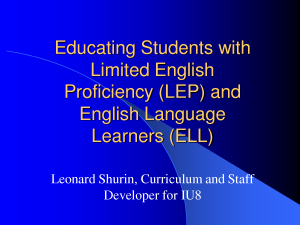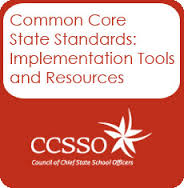K-12 ESL and the Common Core
OVERVIEW
With ESL students comprising 10 percent and Hispanic students comprising 25 percent of the US public school population, and current projections indicating that by the year 2030, 40% of all school-aged children in the United States will be speakers of a first language other than English, K-12 teachers need to be adequately prepared to teach and interact with this culturally blended student population.
English language learners are the fastest growing group of students in the United States today with one out of every nine students in America learning English as a second language. That’s about 5.4 million children – almost the population of Arizona, or Maryland, or Tennessee. Even instructors that aren’t primary ESL teachers should be trained in basic ESL education to best educate their linguistically diverse students.
According to College Board, ESL teachers are not just in demand around the country, but also around the world. The U.S. Department of Education lists English as a Second Language teachers as one of the high-need areas in many states across the nation.
In classrooms where teachers have the basics of ESL instruction they have the immediate potential to greatly affect and impact students. It is imperative that teachers learn how to effectively communicate cross-culturally in such diverse contexts.
HISTORY of ESL in the U.S.
The first evidence of ESL in the U.S. dates back to 1664. In addition to many Native-American languages, at least eighteen languages were spoken in the U.S. during that period. During the 18th and 19th century’s groups with various cultural and linguistic backgrounds migrated across the continent and, starting in 1839, some states began to adopt bilingual education laws that authorized instruction in languages other than English.
However, during the first few decades of the 20th century, immigrants were encouraged to assimilate and to replace their own cultural heritage with a more “American” one. Although some communities taught students in their native languages, non-English speakers were often “submerged” in the English-only classroom with no second language instruction. By the mid-1920s, most bilingual schools throughout the country were dismantled, and English-only instruction continued until the 1960’s, when the government stepped in again to sanction bilingual programs.
1963—Largely as a result of the rise in the number of Cuban immigrants during the 1960s, the first large-scale government-sanctioned bilingual program was initiated in Dade County, Florida, and soon became an unofficial model for the nation. Educators from all over the country came to examine the curriculum in an effort to investigate the use of bilingual schooling for English Language Learners (ELL).
1966—Teachers of English to Speakers of Other Languages (TESOL) (www.tesol.org) a professional organization, was established in response to the increased demand for ESL materials and methodologies due to the influx of immigrants, refugees, and international students to the United States.
1968—Congress passed the Bilingual Education Act under Title VII of the Elementary and Secondary Education Act. This represented the first national acknowledgment of the special educational needs of non/limited-English speaking children. Under Title VII’s “poverty criterion” for eligibility, however, bilingual education was seen as a strategy for “repudiating the effects of poverty and cultural disadvantage”.
1974—A suit by the Puerto Rican Legal and Educational Fund resulted in a Federal court order that required the New York City chancellor of education to develop adequate bilingual programs that included intensive English instruction and some content instruction in Spanish.
1974—In the pivotal Lau vs. Nichols case, the U.S. Supreme Court ruled that Lau and 1,789 other Chinese students in San Francisco were being denied access to equal educational opportunities because they could not sufficiently understand the language of instruction. The Lau case set the expectation that school systems must adopt some kind of comprehensive strategy that addressed the needs of non-English speaking students, though the Court refused to mandate any particular model.
1984—The majority of programs funded by the Elementary and Secondary Education Act (ESEA) were re-organized into two divisions. Title I provides money for disadvantaged students, as well as migrant education programs. Title II provides block grants to the states under such laws as “Ethnic Heritage Act” and the “Emergency School Aid Act.” Funding for Limited English Proficient (LEP) students (another term for ELL), comes from all of these programs to varying degrees.
migrant education programs. Title II provides block grants to the states under such laws as “Ethnic Heritage Act” and the “Emergency School Aid Act.” Funding for Limited English Proficient (LEP) students (another term for ELL), comes from all of these programs to varying degrees.
1998—California’s Proposition 227 was passed during the primary election and effectively restructured education for language minority students by mandating a one-year structured English immersion (SEI) program, although parents can choose to opt out of the program. Proponents of 227 have maintained that LEP students have acquired English at a higher rate since the inception of the proposition in school year 1998-99. Many academics, however, have found no empirical evidence supporting the assertion that LEP students have benefited from the legislation.
2000—The frenzied bilingual debate showed no sign of slowing down. Arizona passed Proposition 203 and effectively ended bilingual education in that state. Led by California software mogul Ron Unz, the non-profit corporation One Nation, One California is pursuing similar legislation in Colorado, New York, Massachusetts, and Texas.
This is obviously only a cursory glimpse at the history of bilingual education, but this summary of laws and events does provide important background and introduce a number of terms that all teachers need to know and understand. (www.teachingasleadership.org)
When the Common Core State Standards (CCSS) were published in 2010, the developers acknowledged that the needs of English language learners (ELLs) should taken into account with implementation. However, beyond providing some general information and pedagogy for ELLs, the developers initially left the question of English language proficiency standards and resources up to the states. Since then, several major national initiatives have begun to address the needs of ELLs as they relate to the CCSS and the role of English language proficiency (ELP). This article provides a brief synopsis of some of these initiatives.
ENGLISH LANGUAGE PROFICIENCY STANDARDS and the COMMON CORE
(The following is from Teachers of English to Speakers of Other Languages www.tesol.org)
When the CCSS were initially published, the question of ELP standards was left up to the states, and no common set of ELP standards was provided. However, the states soon made clear the need for resources and guidance. In September 2012, the Council of Chief State School Officers released an English Language Proficiency Development Framework to assist states in revising their ELP standards to correspond to the CCSS and the Next Generation Science Standards (NGSS).
 Written by leading experts on English language learning and the lead writers of the CCSS, the goal of the Framework is to delineate the language practices that all ELLs must acquire in order to successfully master the CCSS. Aimed at state education leaders, the Framework outlines the language demands of the CCSS and NGSS, and provides a protocol for determining the degree of alignment present between the Framework and a state’s current ELP standards (or those under development). While the Framework does not offer a specific set of ELP standards, nor give pedagogical recommendations, it does highlight how language instruction throughout the four domains (listening, speaking, reading, and writing) can be utilized while adhering to the CCSS and NGSS.
Written by leading experts on English language learning and the lead writers of the CCSS, the goal of the Framework is to delineate the language practices that all ELLs must acquire in order to successfully master the CCSS. Aimed at state education leaders, the Framework outlines the language demands of the CCSS and NGSS, and provides a protocol for determining the degree of alignment present between the Framework and a state’s current ELP standards (or those under development). While the Framework does not offer a specific set of ELP standards, nor give pedagogical recommendations, it does highlight how language instruction throughout the four domains (listening, speaking, reading, and writing) can be utilized while adhering to the CCSS and NGSS.
Many states have already begun revising their ELP standards so that they correspond to the CCSS, for example, New York and California’s English Language Proficiency Standards. There are also now 28 states in the World-Class Instructional Design and Assessment consortium (WIDA), which has released a new edition of “amplified” English language development standards that illustrate the academic language that teachers need to use while implementing the CCSS.
Understanding the Language Project
To help develop resources aimed at supporting English learners to meet the CCSS is a research effort spearheaded by Kenji Hakuta, of Stanford University, and Maria Santos, former director of programs for ELLs for the New York City school system. Backed by private grant funds, Understanding Languages “aims to heighten educator awareness of the critical role that language plays in the new Common Core State Standards and Next Generation Science Standards.” Other key partners include Council of Great City Schools, the New York City Department of Education, the Council of Chief State School Officers, and the National Council of La Raza.
programs for ELLs for the New York City school system. Backed by private grant funds, Understanding Languages “aims to heighten educator awareness of the critical role that language plays in the new Common Core State Standards and Next Generation Science Standards.” Other key partners include Council of Great City Schools, the New York City Department of Education, the Council of Chief State School Officers, and the National Council of La Raza.
This project includes a team of ELL experts and educators (including former TESOL International Association president Lydia Stack) to provide a resource for teachers of ELLs to negotiate and navigate the CCSS in their own classrooms. One of the main goals for the initiative is to highlight the application of language and literacy in all areas of school subjects, not just English and language arts classrooms. The project has released a series of commission papers written by leading language experts that analyze the changes, challenges, and opportunities that the CCSS will provide for teachers of ELLs. In addition, the project has held a series of webinars for educators and is planning materials to assist teachers in working with their ELLs.
English Language Proficiency Assessments
Recognizing the need for English language proficiency (ELP) standards to correspond to the CCSS, the U.S. Department of Education has provided grants to two state-led consortia to develop the  next generation of ELP assessments. According to the provisions of the grants, these new assessments must measure students’ proficiency against some commonly held English language proficiency standards that correspond to a set of college- and career-ready standards in English language arts and mathematics. In addition to producing results that are valid, reliable, and fair for its intended purpose, the new assessment system had to meet additional criteria, including
next generation of ELP assessments. According to the provisions of the grants, these new assessments must measure students’ proficiency against some commonly held English language proficiency standards that correspond to a set of college- and career-ready standards in English language arts and mathematics. In addition to producing results that are valid, reliable, and fair for its intended purpose, the new assessment system had to meet additional criteria, including
-
Be based on a common definition of English learner adopted by all Consortium states;
-
Include diagnostic (e.g., screener or placement) and summative assessments;
-
Assess English language proficiency across the four language domains of reading, writing, speaking, and listening for each grade level from kindergarten through grade 12;
-
Produce results that indicate whether individual students have attained a level and complexity of English proficiency that is necessary to participate fully in academic instruction in English;
-
Be accessible to all English learners with the exception of those who are eligible for alternate assessments based on alternate academic standards; and
-
Use technology to the maximum extent appropriate to develop, administer, and score assessments.
ESL CURRICULUM
One Florida Teacher said after ninety percent of the ESL students in the state failed their assessments, “We just want our kids to pass but we need the learning/teaching materials to do that.” One of the biggest challenges in U.S. ESL is to develop relevant contemporary curriculum that will actively engage today’s EEL students. Interactive digital ESL curriculum is being developed that toggle back and forth between the learner’s native language and English and ESL eBooks contain interactive elements including graphics.
Another successful ESL tool is the graphic novel also known as comic books. Graphic novels can be compared to the Hollywood silent movies of the 1920 where millions of European imagrants learned English by studying the English sub-titles. (see K-12 Entertainment-based eLearning/graphic novels).
The following is from Using Comics to Improve Literacy in English Language Learners
by Amy Baker – (An Abstract of a research paper for the degree of Master of Science in Library Science, University of Central Missouri 2011)
www.centralspace.ucmo.edu/xmlui/bitstream/handle/10768/20/ABaker_LibraryScience.pdf?sequence=1
How Comics Can Benefit English Language Learners
Justine Derrick, author of Using Comics with ESVEFL Students, states that graphic novels can lead students into exploring books, magazines, and other reading materials. Teachers using graphic novels in class are finding students eager to read, recommending books to one another, and creating comics of their own. They have also seen students branching out socially as a result of discussion groups centered on comics and graphic novels.
Comics and ELL Students
Many ELLs are reluctant readers because traditional texts seem overwhelming. Through the aforementioned literature, a strong case can be made for including comics in the ELL classroom. Comics have visual appeal, less text, and some familiar characters that will draw students in. Looking beyond the initial appeal, comics can increase literacy and language acquisition.
Recommendations
As the number of school-aged ELLs grows, it is imperative that these students are supported in their goal of second language acquisition. Educators must be sensitive to cultural differences as these students enter classrooms. Time and support are necessities in this process. Comics and graphic novels have been shown, through research, to be an effective tool in increasing literacy and language acquisition.
Graphic novels are high interest with a low reading level, deal with current events and social issues, and cover diverse genres such as biography, historical fiction, fantasy, and science fiction. With limited dialogue and bold, attractive visuals, graphic novels are much less threatening than traditional novels. For these reasons, graphic novels and comics would be an excellent addition to any classroom or library collection.

Recent Comments